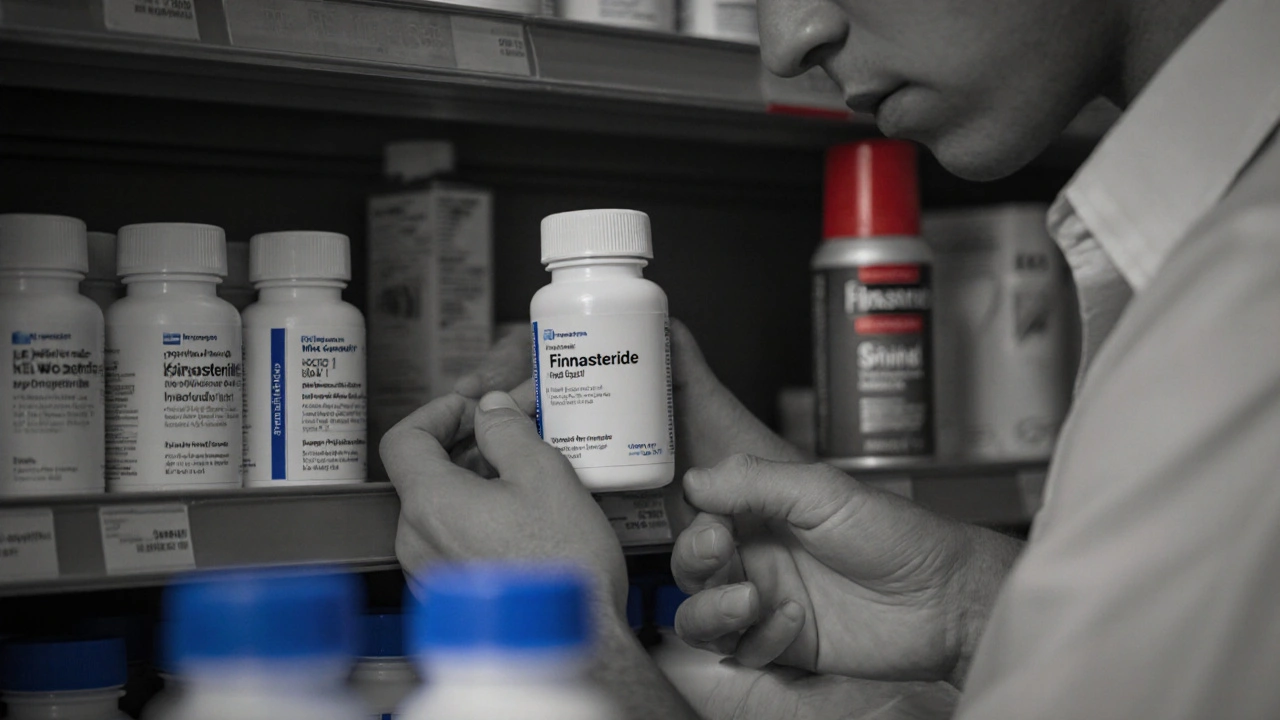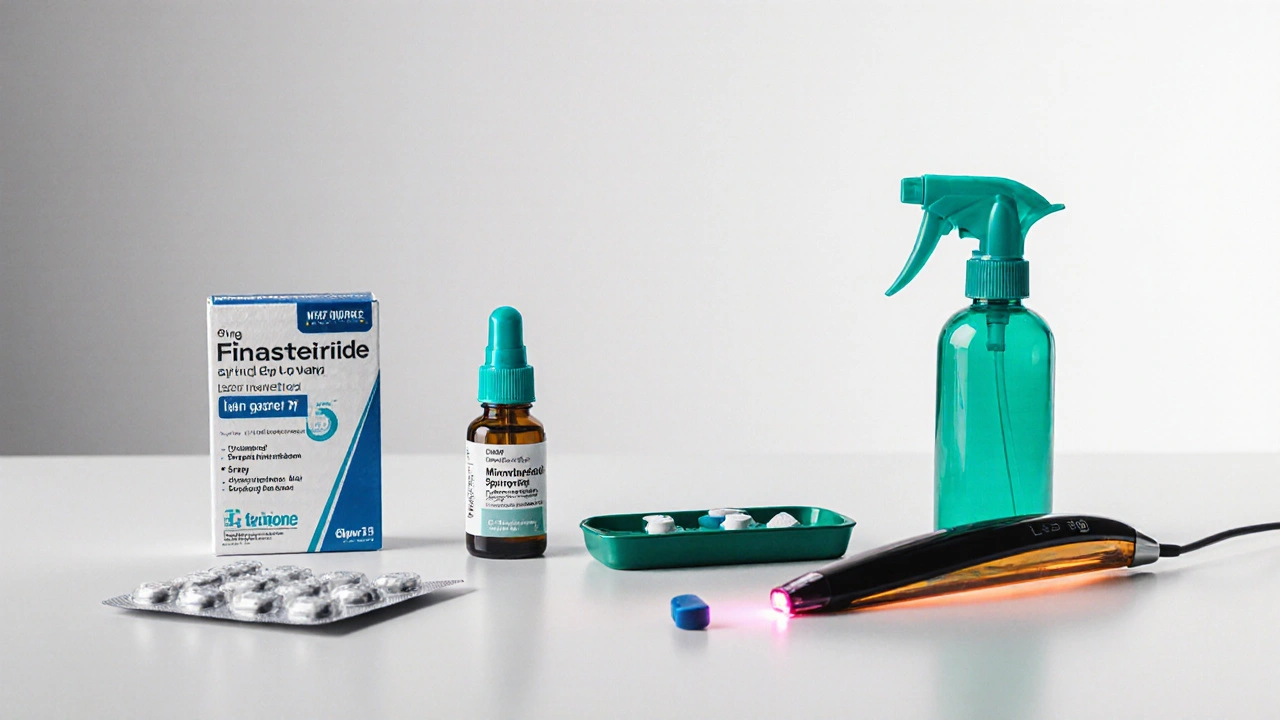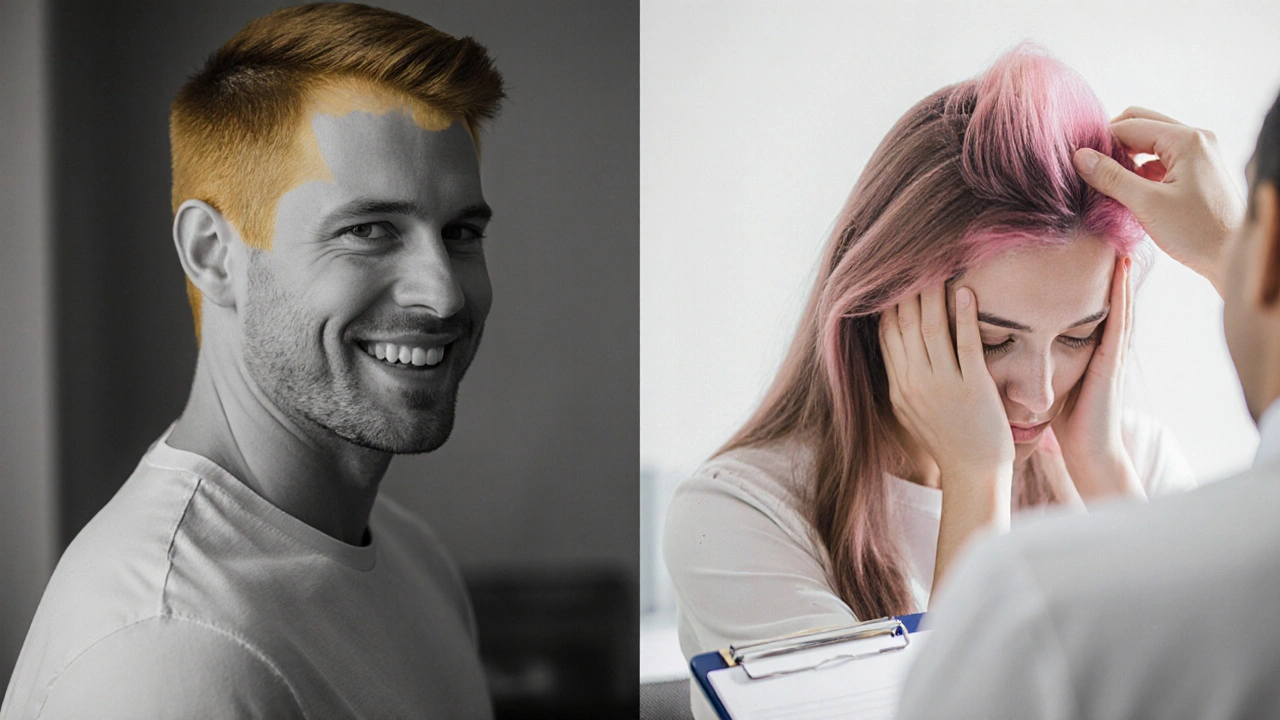Finasteride vs Alternatives: Best Hair‑Loss Treatment for You

Hair Loss Treatment Selector
Answer a few quick questions about your hair loss situation and we'll recommend the most appropriate treatment option from those discussed in the article.
Hair loss can feel like a constant battle, especially when you hear about a new pill or spray every week. If you’re scrolling through pharmacy shelves or online forums, you’ve probably seen Finasteride (often sold as Finast) touted as the go‑to solution for men’s pattern baldness. But is it really the best option, or are there other drugs and therapies that might suit you better? Below we break down how Finasteride works, compare it head‑to‑head with the most common alternatives, and give you a clear checklist to pick the right treatment for your scalp.
What is Finasteride?
Finasteride is a synthetic 5‑alpha‑reductase inhibitor that blocks the conversion of testosterone to dihydrotestosterone (DHT). By lowering DHT levels in the scalp, it slows hair‑follicle miniaturisation, which is the main driver of male‑pattern baldness.
Finasteride was first approved by the FDA in 1992 for treating benign prostatic hyperplasia (BPH) at a 5mg dose (marketed as Proscar). In 1997 the 1mg dose (branded Propecia) gained approval specifically for androgen‑dependent hair loss in men.
How Finasteride Works and What to Expect
Finasteride reduces scalp DHT by about 60‑70% after a month of daily use. Most studies show measurable hair‑growth benefits after three to six months, with peak results around 12months. The drug is taken orally, making it easy to incorporate into a morning routine.
- Dosage: 1mg per day for hair loss; 5mg for BPH.
- FDA approval: United States, Europe, Canada, Australia.
- Common side effects: reduced libido, erectile dysfunction, and rare mood changes.
- Cost: generic versions range from $0.15‑$0.30 per tablet in the US (≈$5‑$10 per month).
Because it’s a prescription medication, a clinician must evaluate your medical history and discuss potential risks before you start.
Top Alternatives to Finasteride
Below are the most widely used alternatives, each with its own mechanism and usage profile.
Dutasteride
Dutasteride is another 5‑alpha‑reductase inhibitor, but it blocks both typeI and typeII enzymes, unlike Finasteride which primarily targets typeII.
Originally approved for BPH (marketed as Avodart), off‑label use for hair loss has grown because it can lower DHT up to 90%.
Minoxidil
Minoxidil is a topical vasodilator that was first sold as a blood‑pressure medication. When applied to the scalp, it prolongs the anagen (growth) phase of hair follicles.
Available over‑the‑counter in 2% (women) and 5% (men) solutions, Minoxidil works for a broader range of hair‑loss patterns, including female‑pattern alopecia.
Spironolactone
Spironolactone is a potassium‑sparing diuretic with anti‑androgen properties. It’s frequently prescribed off‑label for women with hormonal hair loss because it blocks androgen receptors.
Typical doses range from 50‑200mg daily, and it’s usually combined with oral contraceptives to maximise efficacy.
Topical Finasteride
Compounded pharmacies now offer topical Finasteride formulations (0.25‑1% solutions). The idea is to deliver the drug straight to the scalp, reducing systemic exposure and potentially lowering side‑effect risk.
Low‑Level Laser Therapy (LLLT)
Devices such as laser combs and caps use red light (630‑670nm) to stimulate cellular activity in hair follicles. While not a drug, LLLT is FDA‑cleared for both men and women and can be used alongside medication.

Side‑by‑Side Comparison
| Attribute | Finasteride | Dutasteride | Minoxidil | Spironolactone | Topical Finasteride |
|---|---|---|---|---|---|
| Mechanism | 5‑α‑reductase (typeII) inhibitor | 5‑α‑reductase (typeI&II) inhibitor | Vasodilator; prolongs anagen phase | Androgen receptor blocker | Localized 5‑α‑reductase inhibition |
| Prescription? | Yes | Yes (off‑label for hair loss) | No (OTC) | Yes (off‑label) | Yes (compounded) |
| Primary Use | Male pattern baldness | Male pattern baldness (stronger DHT reduction) | Both men & women, diffused thinning | Female androgenic alopecia | Male pattern baldness, lower systemic risk |
| Typical Dose | 1mg daily | 0.5mg daily | 2% or 5% solution, twice daily | 50‑200mg daily | 0.25‑1% solution, once daily |
| Common Side Effects | Sexual dysfunction, mood changes | Similar to Finasteride, possibly higher | Scalp irritation, unwanted facial hair | Breast tenderness, potassium imbalance | Less systemic; mild scalp irritation |
| Cost (US) | $5‑$10 / month (generic) | $30‑$50 / month | $15‑$30 / month | $10‑$25 / month | $30‑$70 / month (compounded) |
Pros and Cons at a Glance
- Finasteride: Proven efficacy for men; low daily pill burden; risk of sexual side effects.
- Dutasteride: Stronger DHT suppression; may work faster; higher cost and similar side‑effect profile.
- Minoxidil: OTC, works for women; requires twice‑daily application; results plateau after a year.
- Spironolactone: Good for women with hormonal loss; can cause blood‑pressure changes; not for men.
- Topical Finasteride: Lower systemic exposure; emerging data; needs compounding pharmacy.
How to Choose the Right Option for You
Pick a treatment based on three practical questions:
- Who are you? Men typically start with oral Finasteride or Dutasteride. Women usually gravitate toward Minoxidil or Spironolactone.
- What’s your hair‑loss pattern? If you have early‑stage recession at the temples, Minoxidil may help while you assess long‑term medication.
- How do you feel about side effects? If sexual function is a top concern, consider topical Finasteride or combine low‑dose oral Finasteride with Minoxidil to potentially reduce the needed dose.
Talk to a dermatologist or primary‑care physician about blood work, especially if you’re considering Spironolactone or Dutasteride, as they monitor hormone levels and kidney function.

Real‑World Success Stories
John, a 32‑year‑old from Auckland, started 1mg Finasteride in 2022. After nine months he saw a 60% reduction in hair‑line recession and kept the medication. When he experienced mild libido dip, his doctor switched him to topical Finasteride, which maintained hair growth with no reported systemic symptoms.
Maria, 27, tried Minoxidil for six months without noticeable regrowth. Her dermatologist then added low‑dose Spironolactone, and within four months her thinning stopped and new hair sprouted along the crown. She cites the combination as a game‑changer because it avoided the higher pill burden of oral Finasteride.
Bottom Line
Finasteride remains a solid first‑line choice for male‑pattern baldness, especially when you want a once‑daily pill with a well‑documented track record. However, alternatives like Dutasteride, Minoxidil, Spironolactone, and even topical formulations provide viable paths when side‑effects, gender, or personal preferences come into play. Use the comparison table and checklist above to discuss options with your clinician and find the plan that fits your lifestyle.
Frequently Asked Questions
Can women use Finasteride?
Finasteride is not approved for women, especially those who are pregnant or may become pregnant, because it can cause fetal abnormalities. Women typically use Minoxidil or Spironolactone instead.
How long does it take to see results with Finasteride?
Most users notice a slowdown in shedding within 3‑4 months, with visible regrowth appearing after 6‑12 months of consistent use.
Is it safe to combine Finasteride with Minoxidil?
Yes, many doctors recommend the combo because Minoxidil stimulates growth while Finasteride reduces DHT, giving complementary benefits. Monitor for scalp irritation.
What are the most common side effects of Dutasteride?
Dutasteride shares Finasteride’s sexual side effects-decreased libido, erectile dysfunction-and can also cause breast tenderness and rare mood changes.
Do I need a prescription for Minoxidil?
No, Minoxidil is available over the counter in most countries. You can buy 2% (women) or 5% (men) solutions at pharmacies or online.

richard king
October 16, 2025 AT 16:27Finasteride rides the throne of hair‑loss solutions like a stubborn monarch, promising a rebirth of follicles while demanding the kingdom of your hormones as tribute. The daily pill becomes a ritual, a tiny emblem of hope swallowed each morning with a sip of coffee. Yet the shadows of reduced libido linger, a whispered reminder that the crown is not without its thorns. Some men cast it aside for dutasteride, chasing that extra ten percent DHT suppression like a daring adventurer. Others stack it with minoxidil, hoping the combo will forge a stronger legion against recession. In the end, the choice is a personal odyssey through side‑effects, cost, and the stubborn desire to keep a full head of hair.
Kris cree9
October 26, 2025 AT 16:27This whole finasteride hype is just another false idol.
Paula Hines
November 5, 2025 AT 16:27When we look at the data the picture becomes more intricate than a simple pill versus spray dilemma the long term studies reveal patterns that are often overlooked the first observation is the latency period where users report minimal change for three to six months this silent phase can be misinterpreted as failure yet it is a physiological adjustment period the second point concerns the hormonal cascade the inhibition of 5 alpha reductase not only reduces DHT but also subtly shifts testosterone equilibrium this shift may affect mood and libido in susceptible individuals the third observation relates to cost the generic finasteride remains affordable for many but insurance coverage varies widely creating a socioeconomic divide the fourth aspect is the off‑label use of dutasteride which offers deeper DHT suppression but carries a comparable side effect profile the fifth consideration is the emerging topical formulations which aim to localize effect and reduce systemic exposure though compounding costs can be prohibitive the sixth factor is patient compliance the daily oral dose requires discipline while topical applications demand ritualistic application twice daily the seventh factor is the interaction with other therapies such as minoxidil where synergistic benefits have been documented many clinicians recommend combination therapy to maximize regrowth the eighth element is the psychological impact the visible slowdown of shedding can boost confidence even before measurable regrowth appears the ninth nuance is the rare but serious mood alterations which some reports link to altered neurosteroid levels the tenth detail is the necessity of regular monitoring of prostate specific antigen levels in older patients using finasteride the eleventh note is the contraindication in women especially pregnant individuals due to teratogenic risk the twelfth point is the variability in individual response some men experience robust regrowth while others see negligible change the thirteenth insight is the importance of setting realistic expectations with patients the fourteenth remark is that discontinuation often leads to reversal of gains within a year the fifteenth and final thought is that the decision matrix must incorporate medical history, gender, cost tolerance and personal preference to arrive at the optimal regimen
Queen Flipcharts
November 15, 2025 AT 16:27In a formal assessment, finasteride presents a well‑documented efficacy profile for androgenic alopecia in males. Its pharmacodynamics are anchored in selective inhibition of type II 5‑α‑reductase, yielding a predictable DHT reduction. Nonetheless, the potential for sexual dysfunction warrants thorough pre‑treatment counseling. Comparative analysis with dutasteride indicates a marginally greater DHT suppression but at increased cost. Ultimately, a clinician‑guided choice, factoring patient tolerance and therapeutic goals, remains paramount.
Yojana Geete
November 25, 2025 AT 16:27Choosing between oral finasteride and the newer topical version hinges largely on personal risk tolerance while some patients adore the convenience of a single daily pill others prefer a scalp‑only application the latter may diminish systemic exposure yet it often comes with a heftier price tag and limited availability